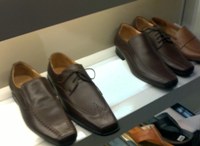(BPT) – Climbing the corporate ladder requires marketable skills, initiative, creativity and … the right shoes? While the importance of proper footwear may seem obvious for professions that require standing or walking all day, such as waitressing, nursing or cooking, poor shoe choices can also trip you up in an office setting.
“At best, sore feet can be a troublesome distraction when you need to concentrate in a meeting or be at your best during a job interview,” says Dr. Matthew Garoufalis, a podiatrist and president of the American Podiatric Medical Association (APMA). “At worst, severe foot injuries from poor footwear can require corrective surgery that puts you out of commission – and out of the office – for extended periods of time.”
While you may assume that some professions are more prone to injury than others, or that women wearing high heels are more at risk, everyone working nine to five should take steps to ensure they head to work every morning wearing shoes that will help – not hinder – how well they do their jobs. The APMA offers some advice for choosing work shoes:
Shoes for women
For many women, wearing dress shoes at the office means wearing high heels five days a week. When you’re choosing a dress shoe for work, whether it’s a high heel or flat, keep these tips in mind:
* Avoid wearing heels higher than two inches. If you choose to wear very high heels for a meeting or other work occasion, limit the time you’re in them and change into a lower, more comfortable pair as soon as possible.
* Vary heel height day-to-day. Look for “walking” pumps – also called “comfort” or “performance” pumps – with mid- to lower-heels. The APMA offers a list of shoes that have earned its Seal of Acceptance for promoting good foot health.
* Look for plenty of toe room. Ideally, pumps with wider, rounded or square toe boxes give your toes more room. Avoid shoes with pointy toes that squeeze digits into unnatural positions. Cramped toes can cause a host of foot woes, from bunions to ingrown toenails.
* Choose wider heels that offer more stability. Stiletto heels and similar pointy heels are less stable and may cause spinal misalignment and ankle injuries.
* Beware ballet flats. You may think no-heel shoes are better for your feet, but often that’s not the case. Ballet flats offer little cushioning or support, and can also cause foot problems such as plantar fasciitis, an inflammation of the tendon that connects the heel bone to the toes.
* Regardless of heel height or shoe style, look for shoes that offer adequate arch and ankle support, and plenty of cushioning.
Shoes for men
* Look for good quality oxford styles – like wing-tip or cap-toe designs – which tend to be best. You can also opt for slip-ons, dressy loafers and low dress boots.
* Avoid wearing the same pair of shoes every day. You should have at least three or four pairs of good quality professional shoes.
* When shoes become too worn to be supportive anymore, replace them. You may be tempted to hold on to that old pair of shoes you love, but apart from looking unprofessional, worn out shoes also provide less support for your feet.
Both men and women should keep a few common tips in mind when shoe shopping:
* Always shop at the end of the day when feet are at their largest.
* Choose quality materials that allow the foot to breathe.
* Look for shoes that offer good support.
* Never buy a pair of shoes that are uncomfortable, assuming you’ll “break them in.” Shoes should be comfortable right away. If they’re not, then they’re not the right shoes for your feet!


